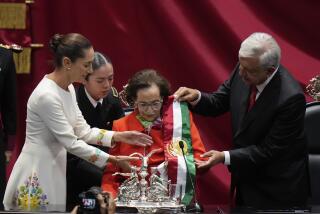Dorothy Height, civil rights icon with core of steel, gets a doodle
- Share via
Dorothy Height, an icon for civil rights as well as women’s rights, is celebrated with a Google doodle today on what would have been her 102nd birthday.
If you said “Dorothy who?” this is for you.
Height stood on the same stage as Martin Luther King Jr. as he told of his dream, was often the lone woman at strategy sessions during the peak of the civil rights struggle, and for 40 years was “laser-focused” on advancing the rights of African American women.
PHOTOS: Remembering the March on Washington
But Height was “not nearly as well known as her male contemporaries,” as her 2010 L.A. Times obituary notes. Given her extraordinary life, her relative lack of renown may be one of the most striking things about Height.
She was an exceptional young student who was accepted to Barnard only to be refused upon her arrival in 1929. “They did not know that I was not white,” Height later said. The school had already met its quota of black students for the year -- two -- “and so when I got there I was turned away.”
She earned her bachelor’s in education and master’s in educational psychology from New York University.
Later, as a YWCA executive in the 1940s, she oversaw its racial integration. She was a staunch civil rights activist and collaborated on strategy with King and others during the peak of the movement in the 1960s. She led the National Council of Negro Women for 40 years, from 1957 to 1998. Alongside Betty Friedan, Gloria Steinem and others, she helped found the National Women’s Political Caucus in 1971.
Height’s lack of fame, the New York Times noted on her death in 2010 at age 98, could be because she was marginalized on two fronts, “pushed offstage by women’s groups because of her race and by black groups because of her sex.”
Yet it’s easy to see the core of steel in Dorothy Height.
The inscription on the Congressional Gold Medal she received in 2004 includes these words: “We African American women seldom do just what we want to do, but always what we have to do.”
She spoke in a 2009 interview with Althea Legal-Miller about the power of black women during the civil rights movement. (Listen to the interview excerpt.)
“When you read about the civil rights movement, you read more about the great men,” she said. “The backbone of the civil rights movement was made up of women, children and youth.”
She recalled a civil-rights-era incident in which a police officer threatened her life. She was at a train station on an oppressively hot day in North Carolina, standing with white colleagues. “They had this little colored waiting room. It was a dingy little room,” she said, and she stood with white colleagues on the platform, trying to stay cool.
“A policeman came and told me I should not be here with these white women” and told her to go to the colored waiting room. “I said, ‘But here’s my train.’” He insisted. She refused.
“He said, ‘If you go to that train, I’ll blow your brains out,’” Height said. Two white colleagues accompanied her to board the train. She recounted the story later to Roy Wilkins, the prominent civil rights activist. He told her, “If you had been a man, you would be dead.”
“So in a sense,” she said, “women could move a little more freely ... There were times that women could do things that men could not.” Realizing that, she said, many women felt the need to act.
Height spent a lifetime working to fight racism and sexism. She may be lesser known, but her legacy is deep.
As Marian Wright Edelman wrote in 2006: “Her fingerprints are quietly embedded in many of the transforming events of the last six decades as blacks, women, and children pushed open and walked through previously closed doors of opportunity.”
Follow me at @AmyTheHub
ALSO:
Dian Fossey, defender of gorillas
“Amazing Grace” Hopper, first lady of software
Google’s pro-LGBT Olympic doodle: What people are saying
More to Read
Sign up for Essential California
The most important California stories and recommendations in your inbox every morning.
You may occasionally receive promotional content from the Los Angeles Times.











